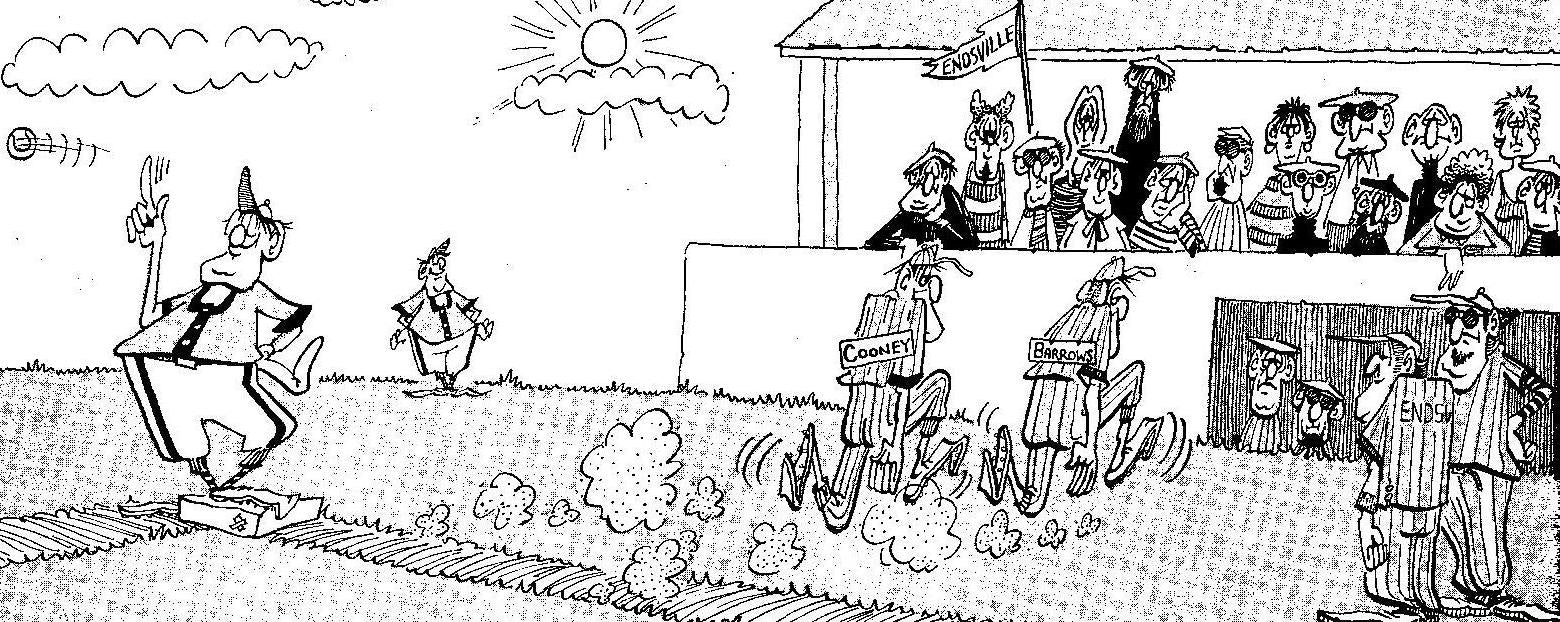
No Joy in Endsville: "Cool" Casey at the Bat

Mad Magazine cover, Number 58, October 1960

The action wasn't groovy for the Endsville nine that day;The beat was 4 to 2 with just one chorus more to sway.And when old Cooney conked at first, and Burrows also sacked,A nowhere rumble bugged up all the cats who dug the act.














ax = instrumentbread = moneycat / cats = hipstersdig = to like / enjoy / approve of, as in "I dig this cat -- he's a gas!"gas = outrageous fungone = high, intoxicated to the point of no returnguts = as in "to beat guts" has a crude contemporary meaning which you can look up on your own time. Here, it probably refers to the gut strings (from ancient times, fashioned from animal intestines) of the guitar or upright bass used in jazz comboslike = typically used as an mild interjection such as "if old Casey could, like, get in one more lick..." with meaning similar to modifiers "sort of" or "kind of"ribble = as in "he fanned down all that ribble.' The exact meaning is unclear, but "ribble" meant at one time to cheat or withhold income from one's employees. More generally, conveys a sense of gratuitous trouble-making.rumble = as in "a nowhere rumble." "Rumble" was a mid-20th-century street fight (as in Sharks vs. Jets), but here intended metaphorically. "Nowhere rumble" = vague disturbance.sick = not used as in 21st-century jargon, meaning "cool" or even "cool/crazy" or "cool/insane." The Beat meaning was, like, old-fashioned "crazy" or "insane"-- and NOT in a "cool" way. (In Thayer's original, the crowd at this point in the game challenges the second strike call with shouts of "Fraud!")sideman = back-up musician in an ensemblesplit = to go, or leave; "A hassled group...started in to split"stick = instrument (also "ax")From Hipsters to Hippies: The Beat Generation and its hipster jargon provided a rich vein of inspiration for Mad artists and writers into the early 1960's. Very soon, however, the hipsters would give way to an even more fruitful source of Mad comedy: "hippies".
Let's consider the credit due to Don Martin himself--the "maddest of the Mad artists," as he was described by contemporaries. Educated at the Newark (N.J.) School of Fine and Industrial Arts, and a graduate of the Pennsylvania Academy of the Fine Arts in Philadelphia (1952), Martin employed his talents in album cover design before he broke into the ranks of Mad in 1956.

At Mad, Martin often applied his creativity to poetic parodies, including versions of poems by Longfellow, Coleridge, Edgar Guest, and Clement Clarke Moore ("A Visit from St. Nicholas"). Besides contributing his distinctively eccentric comic characters, did Martin also help write the verses? Mad provided no clues: Martin is attributed as "artist" in the 1960 "'Cool' Casey at the Bat," but no other attributions are apparent, except to the "usual gang of idiots" recognized collectively behind the front cover as artists and contributors.

Mad Magazine "Beatnik" edition, September 1960
The brilliance of "Cool Casey" lies in the way it deftly juxtaposes the imagery of sports and that of "be-bop" music--in a way that commingles the language and drama of both! When Casey struts in with his "stick" he could be holding either his bat--or his saxophone--and when "...the joint is jumpin' with the sound of Casey's blast," we hear both the crack of the bat and the desperate sforzando of his "ax." And of course Casey is left with the aftermath of his "goof" in a finality with which both athletes and artists can sympathize.
#CaseyattheBat #BalladoftheRepublic
With thanks to George J. Heer and content attribution to Mad Magazine and to the genius of Don Martin



2 comments
Like, too groovy for words, daddyo!
Chuck Dickerson
You left out at least one frame. “Like, Strike Two!” is missing!
Dave
Leave a comment
This site is protected by hCaptcha and the hCaptcha Privacy Policy and Terms of Service apply.